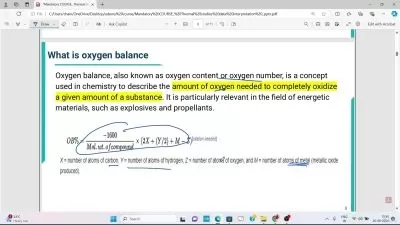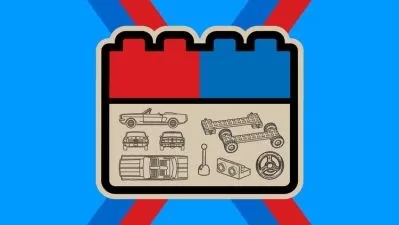Intro to Fluid Mechanics: Bernoulli & Control Volume Appch.
David Morata
4:34:36
Description
Introduction to fluid dynamics, Bernoulli's equation and the Control Volume Approach (Mass cons., Newton's 2nd Law)
What You'll Learn?
- Understand the differences between Eulerian and Lagrangian representations of a flow field
- Learn the definition of streamline, particle path and streakline
- Understand the Bernoulli equation
- Learn on the venturi effect
- Become familiar with tools such as the pitot-static probe or the venturi meter
- Learn the control volume approach and the Reynolds Transport Theorem
- Use the mass conservation equation and Newton's second law using control volumes to calculate flow rates and forces due to fluids in motion
Who is this for?
What You Need to Know?
More details
DescriptionThis is an introductory course on fluid mechanics in which you will learn the basics of this beautiful science. This course is the second in a three-course series that will provide you with the fundamental tools that you need to start solving several exciting fluid mechanics problems. The materials you will learn in this course are taught in undergraduate programs across the world in Engineering sciences. After enrolling to this course you will get lifetime access to its materials, which include easy to follow lecture videos on theory and examples.
Here's what you will learn in this course:
First we will describe the differences between the Eulerian and Lagrangian representation of a flow field. This will naturally lead us to talk about the different fluid flow lines: streamlines, particle paths and streaklines. We will define the streamline mathematically and solve practice problems. After that, we will derive the Bernoulli equation along a streamline and introduce different concepts such as the venturi effect. We will discuss on the applications of Bernoulli's equation and several devices such as the pitot probe or the venturi meter. Finally, we will learn about the control volume approach - a very powerful concept in fluid dynamics to find flow rates and forces due to fluids in motion. We will discuss the mass conservation equation and Newton's second law. And we will solve many practice problems.
I am a strong believer that practice makes the master. As such, I will provide you with many worked out example problems, as well as practice problems, to help you develop your fluid mechanics skills. These problems will be diverse: from forces acting on a dam, to determining the drag of an airplane.
Fluid mechanics can be complicated. That is why the course is designed to help you understand the fundamentals of fluid mechanics, in which we will discuss the derivations of the equations and will show plenty of worked out examples to help you study.
Here are the chapters covered in this course:
Chapter 1 - Fundamentals: definitions of a fluid, fluid properties, viscosity, definition of shear stress, shear strain rate, Newtonian fluids.
Chapter 2 - Hydrostatics: derivation of the hydrostatics equations, standard atmosphere model, expressions for the pressure, forces on submerged objects of planar and curved shapes, buoyancy.
And these are the areas in which you will excel after finishing this course:
Define what is a fluid
Find the shearing stresses on a fluid and relate them to velocity differences
Describe the fundamental fluid properties
Understand pressure
Find the forces on submerged planar objects of arbitrary shapes
Find the forces on submerged objects of curved shapes
Solve buoyancy problems
Generally describe fluid dynamics
I hope you enjoy taking the course as much as I enjoyed teaching it! It is recommended to be familiar with fundamental calculus (e.g., derivatives, integration, etc.) and physics (solid-body diagram, Newton's second law, etc.) for taking this course.
See you in the class!
Who this course is for:
- People curious on fluid mechanics
- Undergraduate students
This is an introductory course on fluid mechanics in which you will learn the basics of this beautiful science. This course is the second in a three-course series that will provide you with the fundamental tools that you need to start solving several exciting fluid mechanics problems. The materials you will learn in this course are taught in undergraduate programs across the world in Engineering sciences. After enrolling to this course you will get lifetime access to its materials, which include easy to follow lecture videos on theory and examples.
Here's what you will learn in this course:
First we will describe the differences between the Eulerian and Lagrangian representation of a flow field. This will naturally lead us to talk about the different fluid flow lines: streamlines, particle paths and streaklines. We will define the streamline mathematically and solve practice problems. After that, we will derive the Bernoulli equation along a streamline and introduce different concepts such as the venturi effect. We will discuss on the applications of Bernoulli's equation and several devices such as the pitot probe or the venturi meter. Finally, we will learn about the control volume approach - a very powerful concept in fluid dynamics to find flow rates and forces due to fluids in motion. We will discuss the mass conservation equation and Newton's second law. And we will solve many practice problems.
I am a strong believer that practice makes the master. As such, I will provide you with many worked out example problems, as well as practice problems, to help you develop your fluid mechanics skills. These problems will be diverse: from forces acting on a dam, to determining the drag of an airplane.
Fluid mechanics can be complicated. That is why the course is designed to help you understand the fundamentals of fluid mechanics, in which we will discuss the derivations of the equations and will show plenty of worked out examples to help you study.
Here are the chapters covered in this course:
Chapter 1 - Fundamentals: definitions of a fluid, fluid properties, viscosity, definition of shear stress, shear strain rate, Newtonian fluids.
Chapter 2 - Hydrostatics: derivation of the hydrostatics equations, standard atmosphere model, expressions for the pressure, forces on submerged objects of planar and curved shapes, buoyancy.
And these are the areas in which you will excel after finishing this course:
Define what is a fluid
Find the shearing stresses on a fluid and relate them to velocity differences
Describe the fundamental fluid properties
Understand pressure
Find the forces on submerged planar objects of arbitrary shapes
Find the forces on submerged objects of curved shapes
Solve buoyancy problems
Generally describe fluid dynamics
I hope you enjoy taking the course as much as I enjoyed teaching it! It is recommended to be familiar with fundamental calculus (e.g., derivatives, integration, etc.) and physics (solid-body diagram, Newton's second law, etc.) for taking this course.
See you in the class!
Who this course is for:
- People curious on fluid mechanics
- Undergraduate students
User Reviews
Rating
David Morata
Instructor's Courses
Udemy
View courses Udemy- language english
- Training sessions 28
- duration 4:34:36
- Release Date 2024/06/16









